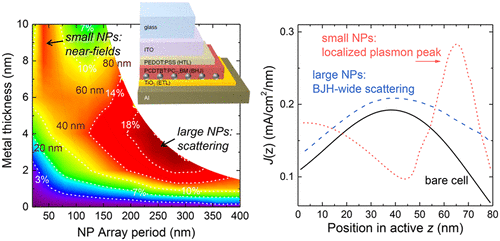当前位置:
X-MOL 学术
›
ACS Photonics
›
论文详情
Our official English website, www.x-mol.net, welcomes your
feedback! (Note: you will need to create a separate account there.)
Plasmonic Organic Photovoltaics: Unraveling Plasmonic Enhancement for Realistic Cell Geometries
ACS Photonics ( IF 6.5 ) Pub Date : 2018-01-23 00:00:00 , DOI: 10.1021/acsphotonics.7b01390 Ioannis Vangelidis 1 , Anna Theodosi 1 , Michail J. Beliatis 2 , Keyur K. Gandhi 2 , Argiris Laskarakis 1, 3 , Panos Patsalas 1, 3 , Stergios Logothetidis 3 , S. Ravi P. Silva 2 , Elefterios Lidorikis 1
ACS Photonics ( IF 6.5 ) Pub Date : 2018-01-23 00:00:00 , DOI: 10.1021/acsphotonics.7b01390 Ioannis Vangelidis 1 , Anna Theodosi 1 , Michail J. Beliatis 2 , Keyur K. Gandhi 2 , Argiris Laskarakis 1, 3 , Panos Patsalas 1, 3 , Stergios Logothetidis 3 , S. Ravi P. Silva 2 , Elefterios Lidorikis 1
Affiliation

|
Incorporating plasmonic nanoparticles in organic photovoltaic (OPV) devices can increase the optical thickness of the organic absorber layer while keeping its physical thickness small. However, trade-offs between various structure parameters have caused contradictions regarding the effectiveness of plasmonics in the literature, that have somewhat stunted the progressing of a unified theoretical understanding for practical applications. We examine the optical enhancement mechanisms of practical PCDTBT:PC70BM OPV cells incorporating metal nanoparticles. The plasmonic near- and far-field contributions are differentiated, with spectrum- and space-wide current enhancements found in the plasmon scattering regime and spectrum- and space-specific current enhancements in the near-field regime. A remarkable system complexity is revealed, where the plasmonic enhancement trends change and even reverse by simple changes in the device geometry. This accounts for many of the contradictory results published in the literature on plasmonic effects in OPVs. By exploring the full structural parameter phase-space we are able to now propose a unified representation that intuitively explains literature findings and trends. Our results show that an already optimized PCDTBT:PC70BM cell can be further optically enhanced by plasmonic effects by at least 20% with the incorporation of Ag nanoparticles.
中文翻译:

等离子有机光伏:揭开实际细胞几何形状的等离子增强。
将等离激元纳米粒子掺入有机光伏(OPV)装置可以增加有机吸收层的光学厚度,同时保持其物理厚度较小。然而,各种结构参数之间的权衡已导致关于等离子体激元学的有效性的矛盾,这在一定程度上阻碍了对实际应用的统一理论理解的发展。我们研究了实用的PCDTBT:PC 70的光学增强机制包含金属纳米粒子的BM OPV电池。等离子体的近场和远场贡献有所不同,在等离激元散射方案中发现了频谱和空间范围的电流增强,而在近场方案中发现了特定于频谱和空间的电流。揭示了显着的系统复杂性,其中等离子体增强趋势通过设备几何形状的简单变化而改变甚至逆转。这解释了在OPV的等离激元效应的文献中发表的许多相互矛盾的结果。通过探索整个结构参数的相空间,我们现在可以提出一个统一的表示形式,直观地解释文献发现和趋势。我们的结果表明,已经优化的PCDTBT:PC 70通过掺入Ag纳米颗粒,可以通过等离子体效应将BM细胞进一步光学增强至少20%。
更新日期:2018-01-23
中文翻译:

等离子有机光伏:揭开实际细胞几何形状的等离子增强。
将等离激元纳米粒子掺入有机光伏(OPV)装置可以增加有机吸收层的光学厚度,同时保持其物理厚度较小。然而,各种结构参数之间的权衡已导致关于等离子体激元学的有效性的矛盾,这在一定程度上阻碍了对实际应用的统一理论理解的发展。我们研究了实用的PCDTBT:PC 70的光学增强机制包含金属纳米粒子的BM OPV电池。等离子体的近场和远场贡献有所不同,在等离激元散射方案中发现了频谱和空间范围的电流增强,而在近场方案中发现了特定于频谱和空间的电流。揭示了显着的系统复杂性,其中等离子体增强趋势通过设备几何形状的简单变化而改变甚至逆转。这解释了在OPV的等离激元效应的文献中发表的许多相互矛盾的结果。通过探索整个结构参数的相空间,我们现在可以提出一个统一的表示形式,直观地解释文献发现和趋势。我们的结果表明,已经优化的PCDTBT:PC 70通过掺入Ag纳米颗粒,可以通过等离子体效应将BM细胞进一步光学增强至少20%。











































 京公网安备 11010802027423号
京公网安备 11010802027423号